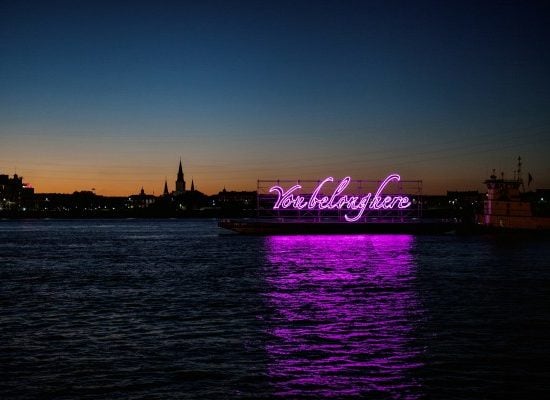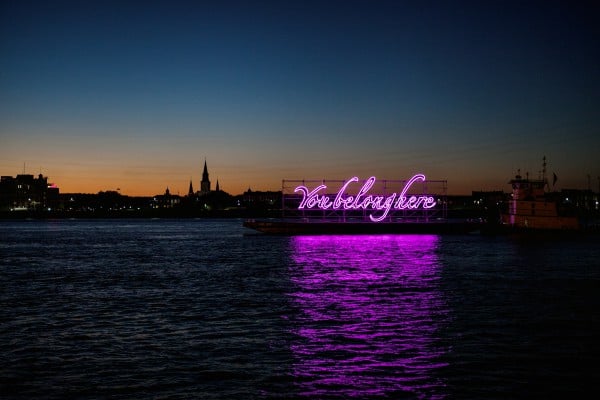Reviews
Prospect.3 Trains Its Eye Provocatively on the Art World’s Social Failings
The show is a crossroads for art to gauge itself against real-world problems.
The show is a crossroads for art to gauge itself against real-world problems.
Christian Viveros-Fauné


“Somewhere and not Anywhere.” That’s the way Binx Bolling, the protagonist of Walker Percy’s 1961 novel The Moviegoer, describes his ideal digs in New Orleans. Describing a place that is familiar yet in no way humdrum, the phrase feelingly captures this dynamic city nearly a decade after Hurricane Katrina. A location that historically touts its brilliant food, music, literature, dance, and local culture galore, the Crescent City is also currently the epicenter of a sparkling Prospect.3—one of the best international art biennials, anywhere, in recent memory.
Curated by LACMA Senior Curator Franklin Sirmans, Prospect.3 capitalizes on a growing undercurrent of impatience with curatorial business-as-usual. Subitled Notes for Now, Sirman’s biennial takes as its starting point Percy’s Big Easy existentialist novel, as well as two other alternative conceptual touchstones: Tarsila do Amaral’s anthropofagia movement, which set out to “cannibalize” European art in 1920s Brazil, and Paul Gauguin’s turn-of-the-20th century confrontation with Tahitian otherness. Besides relating directly to the hybrid fabric of New Orleans, these Rosetta Stones don’t just provide an eloquent alt-universalist rereading of modernism, they propose a brief history for 21st century art with a social conscience. Call it creole altermodernism.
A show of 58 artists spread around 18 far-flung locations, Notes for Now is highly prospective but rarely preachy in its plural encounters with both local and global realities. Starting with multiple references to Gauguin’s life-cycle masterpiece Where Do We Come From? What Are We? Where Are We Going?—a replacement Gauguin, Under the Pandanus (I Raro te Oviri), is on view at the New Orleans Museum of Art (NOMA)—the show cannily asks more questions than it proposes answers. Picking up on the desire among artists to increasingly find inspiration outside their studios, Prospect.3 presents heaps of engagé art, while oddly avoiding social practice. (The major exception is Mary Ellen Carroll’s ingenious remaking of UHF bandwidth into free public WiFi along the city’s low-income I-10 corridor.) But if the current exhibition is short on effective art-as-activism, it is chock-full of a growing wave of multidisciplinary social realism. Repeatedly, the mostly compelling work displayed at Prospect.3 privileges the actual over the virtual, the local over the global, and the committed over art for art’s sake.
Because New Orleans and Louisiana are at once so culturally rich and yet so elementally bogged down in crime, corruption, poverty, and unemployment, the city provides an important crossroads for contemporary art to gauge itself against real-world problems. As Sirmans points out in his catalog essay, Louisiana is not called “the world’s prison capital” for nothing. It has, he says, “an incarceration rate nearly five times that of Iran, thirteen times that of China.” According to The Guardian, if New Orleans were a nation, it would have the second highest homicide rate in the world. Additionally, an apartheid of economic and social opportunity still applies in the homeland of Plessy v. Ferguson—the Supreme Court decision that established the doctrine of “separate but equal.” Like the developing world, New Orleans remains uniquely vulnerable to natural and manmade disasters. Unlike Venice, Kassel, or New York, the city nearly demands that contemporary art train its eye on its own and the world’s social failings—at the very least symbolically.
That partly explains the packed house attending Andrea Fraser’s electrifying performance at NOMA during Prospect.3’s opening festivities. Titled Not Just A few of Us, Fraser ventriloquized several hours’ worth of mesmerizingly rancorous 1991 city council testimony on the subject of desegregating Mardi Gras floats (the artist’s not-to-be-missed redux performance will take place during the week of January 18). Other Prospect.3 works at NOMA include paintings by de Amaral and anthropomorphic totems by the Choctaw-Cherokee artist Jeffrey Gibson. Fraser also has a sculpture made of discarded carnival costumes at Tulane’s Newcomb Art Gallery. Part of a tidy show that should be called The Dark Side of Carnivalesque, it also includes a room-sized bead-and-string drawing of postcolonial motifs by the Guyana-born Hew Locke; mirror wall sculptures that resemble futuristic corporate logos by 90-year-old Iranian artist Monir Farmanfarmaian; and mixed-media images of violence done in pattern and glitter by the young Jamaican artist Ebony G. Patterson.

Monir Farmanfarmaian, Convertible Series, Group 10 (2011)
Mirror and reverse glass painting on plaster and wood, 4 parts, 47” x 47” x 1.25”
Photo: Courtesy of the artist and Haines Gallery, San Francisco
A genuinely effortless globalism plays out all over Prospect.3, but perhaps nowhere so breezily as at the Contemporary Arts Center New Orleans—the awkward architectural space holding the lion’s share of artists’ work. Highlights include Yun-Fei Ji’s room-sized scroll drawing of the upheaval caused by the construction of the Three Gorges Dam on the Yangtze River; Brazilian Lucia Koch’s cuttingly lyrical paint-on-glass-and-Plexiglass installation; L.A. artist Glenn Kaino’s multiple connect-the-dots metaphors made from live coral and casts of decommissioned tank parts; and Peruvian-born David Zink-Yi’s two-channel video of Cuban ritual singers sauntering in and out of rhythmic possession. The saturated color photographs of New Orleans resident Sophie T. Lvoff additionally provide a timely gentrification-themed coda for the show: Images of corners of the city where the old and the new meet, they capture the kind of dilapidated beauty that can’t help but be fleeting.
The Art Newspaper’s Julia Halperin has called Prospect.3 “the most racially diverse biennial in recent history,” but its representatives have been curiously mum on the subject. The numbers indicate that of the 58 exhibited artists, 22 are African-American and 44 are artists of color. Brooke Anderson, Prospect’s executive director, said officially about the show’s statistics: “We didn’t talk about it.” Which leads one (to want) to believe that this may be the biennial of the future. Will it ever be possible, one wonders, to have large-scale surveys like this one in major American cities where ethnic quotas fill themselves and critics don’t have to do head counts to pump for gender-equality?
Two works that are slightly off-the beaten path provide their own answers. On view at historically black Dillard University is William Cordova’s excellent but historically skeptical Component One: untitled (Soul Rebels Band vs. Robert E. Lee: or silent parade), a literal face off between a statue of the Confederate general and a local eight-piece brass band. On the other, is Tavares Strachan’s You Belong Here: a football-field sized pink neon sign on a barge that floats up and down the Mississippi River, starting at sundown. The biennial work that deserves the most Mardi Gras beads, Strachan’s corporate-sized signage both embraces the idea that shows like this can successfully take on urgent questions, and sets it adrift: Who belongs? Where is here? What is belonging?

Tavares Strachan, You Belong Here (2014)
Blocked out Neon 30 x 80 Ft.
Photo: Courtesy of the artist